Text
KMB215 Jack Rienecker Research Task
When attending a live music event, you expect the music to be loud. Sometimes extremely loud. At hundreds of venues around Australia and the world, having to scream to the person beside you in able to be heard is normal. A majority of live music fans wouldn’t have it any other way. However, research conducted primarily over the last 20 years has proved that regular attendance of live music events, or even irregular, can lead to permanent hearing damage. The evidence is indisputable, yet relatively little is being done by leading music industry professionals to tackle the problem, and even less care is being shown by the general public. This essay will outlay the evidence that Noise Induced Hearing Loss (NIHL) is a growing issue worldwide, examine the reasons behind the Australian Music Industries indifference to the subject, and suggest possible solutions to the increasingly large issue.
Since the relatively recent invention of the Dynamic Speaker in 1925, Loudspeaker technology has progressed dramatically. While the basic mechanics have stayed the same, the gradual increase in quality and power of loudspeakers only plateaued in the early 1990s. It is primarily since then that research has been conducted on the specific effects that live music has on the ear. Research into NHIL, outside of the music industry, has been conducted since the early 1950s. However, it is only in the last couple years that scientists have begun to fully understand the inner workings of the ear, and thus the issue of NHIL has been brought to the forefront of public attention.
The actual science behind NHIL and its many subcategories of effects is complex. The damage is inflicted primarily on hair cells inside the ear, whose job it is to turn sound waves into an electrical signal which travels to the brain. When these hair cells are damaged, they cannot repair themselves, and the electrical signals they send are impaired. The hair cells can be damaged by short bursts of noise greater than 130 db, and sustained exposure to sound greater than 85 db. The typical rock concert will have an average decibel level of 110.
In 2017, The World Health Organisation made a worldwide resolution on the prevention of deafness and hearing loss. In 2015, numerous American mainstream news outlets including CNN, Fox and CNBC published stories on the subject, headlines focusing on the current “epidemic” of hearing loss sweeping the country. The role of live music in this “epidemic” was investigated shortly after, with articles in Australia published by The Daily Herald and The Australian centred around the hearing loss of industry professionals, and the dangers of loud concerts. Further attention to the issue was brought through the the added testimony of several high profile musicians including Lars Ulrich, Phil Collins and Chris Martin. As of 2016, 5 percent of the worlds population suffers from disabling hearing loss and it is estimated that over a billion children at at significant risk within the coming 10 years.
However, though there has been a increase in coverage from the mainstream media on the subject and new scientific data discovered, inside the music industry there has been little to no change in policies or attitudes regarding venues producing dangerously loud music.
In March 2018, Christopher Goldsheider received 750,000 thousand pounds after winning his civil lawsuit against the Royal Opera House of London, in which he proved that as a member of the orchestra, he suffered irrevocable hearing damage due to “acoustic shock”. This shock, which resulted in Tinnitus and Hyperacusis, forced Goldsheider to abandon his career as a successful cellist. The case marked the first time the legal system of any country “… has explored the music industry’s legal obligations towards the hearing of musicians, and the first time that acoustic shock has been recognised as a compensatable condition by the court.” (Fry, 2018). Fry suggests that his has case will encourage other musicians and music industry professionals to seek compensation for the NHIL they suffer as a result of . However there is nearly no other cases of patrons or employees of live music suppliers taking legal action with regards to their NIHL, though an average of 75% of musicians aged 25 to 75 suffer from constant tinnitus. There are numerous cases of workers in construction receiving compensation for NIHL. In 2006, Fair Work Australia released their report on Occupational Hearing Loss, revealing that the total cost of compensation claims was over 30 million dollars, the vast majority of those being made by construction workers. If 75 percent of working musicians suffer from NIHL, why is there so little dialogue on the issue within the industry?
The first aspect of explaining the industry deliberate ignorance to NIHL is the nature of the industry itself. Chris Fry, Goldshieders lawyer in his case against the Royal Opera House, summarises the situation: “The Music Business has considered itself exempt from the same regulatory requirements as all other sectors because of the artistic nature of its output. This in our view has always been a dismissive view from an industry which creates and sells ‘noise’ as a product.” (Fry, 2018). Mrs Justice Davies goes further in saying that “the (opera house’s) reliance upon “artistic value” implies that statutory health and safety requirements must cede to the needs and wishes of the artistic output of… (the venue)… Such a stance is unacceptable, musicians are entitled to the protection of the law as is any other worker.” The importance of the words of both Fry and Davies cannot be underestimated, as the Goldsheider case is the first ever in which a musical venue has been held accountable for the NIHL it has caused. Because the music being performed is the reason that the musicians have a job, and the reason that the audience is there, it is deemed acceptable by venues that said music could be harmful. It is what both the audience and musicians signed up for. This attitude, shared by the majority of industry heads and venue owners, is often shared by musicians. There is significant evidence that artists and band members feel that tinnitus, hyperacusis and other ailments are “just part of the job” (Mcginnity, 2015). Steve Kelby, a local Brisbane musician and sufferer of tinnitus, will often “play through the pain” (Kilby, 2018) for the sake of the song. This attitude that musicians and industry professionals share towards NIHL and the damage their actions are causing, is the main roadblock standing in the way of progress. The second roadblock is similar in that it is psychological in nature, rather than physical. And it is that wearing any sort of hearing protection, as a musician or audience member, is considered to be “uncool”. A study in 2005 by the Canadian Public Health Organisation on attendees of a rock concert found that 85% suffered from temporary tinnitus. However, 80% of those surveyed also said they had never tried using hearing protection, the main reason being how earplugs made them look. This is a issue that is a part of the culture of the live music scene, in which status and appearance are seen as important, and is not easily fixed. The process of normalising hearing protection in the minds of gig goers begins with making them readily accessible.
One straightforward and statistically backed method to increase the use of hearing protection at live music events is to make earplugs available on site, placed in a prominent area. In several Scandinavian countries, such as Switzerland and Denmark, it is federal law that venues must make hearing protection available to all attendees. In two independent surveys of American festival goers, 60% and 83% said they would be willing to use earplugs, if the items were free and easy to access.
Scandinavia is also leading the world in government policy on noise regulations at live music venues. In 1996, to tackle the rapid rise of NIHL in the country, the federal health office of Switzerland imposed laws that made it illegal for bars and clubs to play music at an hourly volume more than 93 decibels. Not long after Sweden, Denmark and Austria followed suit, implementing similar laws throughout their live music scenes. The problem that Australia, America and several other countries have, that of an industry culture that accepts NIHl as occupational hazard, would be easily solved by strictly enforced government legislation. Venue’s will no longer be able to endanger their patrons and staff through unchecked volume levels.
Trying to change the established culture of the Australian music industry through Government regulation could be seen as problematic, the wrong way to correct the problem. However, very little would change in the venues itself. An adoption of laws similar to Switzerland’s would be simple to implement; it would only involve the man behind the desk turning the sound down. Mandatory provision of free earplugs will cost money to install. However, if the Australian government is prepared to take the problem seriously, steps can be taken immediately that could lead to a clearer future, for lovers of live music nationwide.
References
Chris Fry. 2018. The High Court finds that the music industry does have legal obligations towards the hearing of musicians. http://www.frylaw.co.uk/archives/articles/the-high-court-finds-that-the-music-industry-does-have-legal-obligations-towards-the-hearing-of-musicians/
G. Vaughn. 2018. Deafness and Hearing Loss. http://www.who.int/news-room/fact-sheets/detail/deafness-and-hearing-loss
Isaac Bogoch. 2005. Perceptions About Hearing Protection and Noise-induced Hearing Loss of Attendees of Rock Concerts. Canadian Journal of Public Health, Volume 96.
Jeannie H. Chung. 2005. Evaluation of Noise-Induced Hearing Loss in Young People Using a Web-Based Survey Technique. American Academy of Paediatrics, Volume 115.
Jeff Notage. 2001. Swiss Music Festivals Tackle Noise Levels. https://www.swissinfo.ch/eng/swiss-music-festivals-tackle-noise-levels/2248840
Joyce Cohen. 2015. Could one concert do a lifetime of damage to your ears? http://www.dailyherald.com/article/20150803/entlife/150809940/
M. Bethseda. 2017. Noise Induced Hearing Loss. https://www.nidcd.nih.gov/health/noise-induced-hearing-loss
Olsen Widon. 2004. The influence of socio-economic status on adolescent attitude to social noise and hearing protection. Noise and Health, Volume 7.
Paul Donoughue. 2018. ‘Don't be as stupid as I was': How Natalie's nights out left lasting tinnitus and hearing damage. http://www.abc.net.au/news/2018-02-28/hearing-loss-music-fans-self-inflicted-wound/9485268
Peter Rabonwitz. 2003. Nice Induced Hearing Loss. http://hannaziegler.tripod.com/ent/varia/rabinowi.pdf
Robert Garran. 2006. Work Related Noise Induced Hearing Loss in Australia. https://www.safeworkaustralia.gov.au/system/files/documents/1702/workrelated_noise_induced_hearing.pdf
Robert Y. Nelson. 2005. The Global Burden of Occupational Noise-induced Hearing Loss.
The American Journal of Industrial Medicine.
Siobhan McGinnity. 2015. PBS Interview of Hearing Loss and Music. https://hearsmart.org/pbsfm-interview/
Stephan Dance. 2014. Musicians at high risk of hearing loss, but the show can go on. https://theconversation.com/musicians-at-high-risk-of-hearing-loss-but-the-show-can-go-on-26134
V. Mercier. 2003. The Sound Exposure of the Audience at a Music Festival. Noise and Health, Volume 25.
William Clark. 1999. Effects of Noice on Hearing. JAMA.
0 notes
Text
Woodford Folk Festival 2017-18 Reflection
When two of my best friends told me I should join them in volunteering at Woodford Folk Festival at the turn of the year, I was initially hesitant. I’d never been to a festival before, and in my mind Woodford was a place for old people and hippies. Both of which I’m not. However they persisted, and I looked into it. After all, five days of free music and camping with my friends didn’t sound so bad.

My prejudices of Woodford turned out in some ways to be accurate. There were plenty of hippies (some of which didn’t believe in clothes) and you could find old people in a abundance. But that didn’t matter, because in my five days of working behind a very busy bar, every customer I served was incredibly kind. I didn’t receive an angry word the whole week. The culture of Woodford is truly special, and the musical experiences that the festival provided were incredibly unique.

Going into the festival, I wasn’t convinced the quality of music on display would be poor, as I knew almost none of the acts excluding the headliners. As a massive fan of live music, the lack of well known artists was concerning. I was also confused why bands played more than one set. Many bands played nearly four of the five days, and I couldn’t fathom why that would be.

However, talking to my friends (who are Woodford veterans) made me realise that my fears and perceptions were misguided. There were certainly very few names I knew, but I was missing the point completely.

At the majority of Australian Festivals (Splendour, Falls etc), you buy a ticket to see your favourite artists. Line-up announcements are awaited with baited breath; a headline act can make or break a festival. However at Woodford, the reason you buy a ticket or volunteer (and it does sound incredibly cheesy) is to be part of something greater than yourself. The popularity of the headlining acts is barely a factor; people buy tickets to get the “Woodford Experience”. This experience, in regards to the music, is seeing a band with 200 friends. Everyone is happy, everyone is accepting; you feel no pressure to conform or to hide anything. I talked to many people who said that experiencing music at Woodford is incredibly cathartic, and feel the same way.

Another massive part of the festivals musical appeal is the emphasis put on “Discovery”. Instead of planning out their day based on their favourite artists, a Woodford-er can browse the catalogue that contains summaries of each act, and see if any peeks their interest. If you like a certain act, you have to option of seeing them twice, or even three times! This gives you a chance to build a relationship with your favourite artists, and also to become familiar with their songs. Upon leaving the festival, its very likely you’ll have a list of quality new bands on your Spotify.

Another unique aspect about Woodford is that, while music is a major part, the festival has so many non-music related activities (craft, comedy, open panels etc) that often the crowds watching the music are quite small. When Holy Holy (in my opinion one of Aus’ top 5 bands) played on the second to last night, I was shocked how little people attended. However, this did not detract from the experience, rather it made it that much more special. The show was intimate, and every member of the audience was evidently a massive fan. At almost any other Australian music festival, a Triple J endorsed band would attract a massive crowd, and inevitably some audience members would not be too interested.

The theme of discovery, the opportunity to form a connection with an act over several days, small and intimate shows; these are just a couple examples of the unique musical experience Woodford Folk Festival offers.
0 notes
Text
Chvrches - A Promotional Campaign Analysis
Timeline of 2018
30th January - Chvrches delete all content on their Facebook, Twitter and Instagram accounts, leaving them completely blank. They then post a 21 second video of lead singer Lauren Mayberry drawing a crossed hear on a mirror. Music plays over the second part of the video, which is obviously their style of music (new music).
31st January - Their lead single “Get Out” is debuted on BBC’s Radio 1, the largest station in Britain. The average age of Radio 1’s audience is 33.
1st - 10th February - The band promote their new single on all three social media platforms, leaving links to Amazon, Spotify and Apple music.
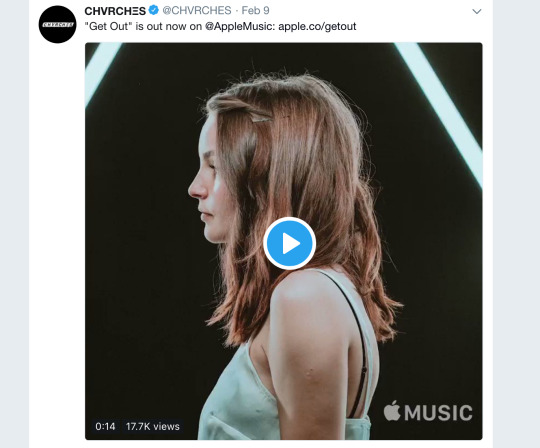
11th February - First advertisement of merchandise, over all social media.
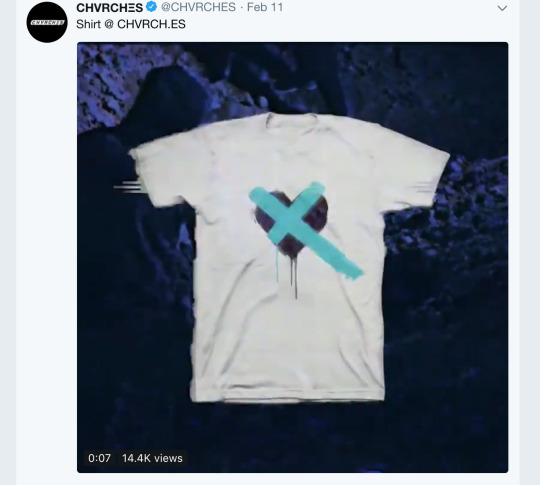
26th February - Chvrches release the track list of their upcoming album through all social media in the form of a photograph, with accompanying lyrics.
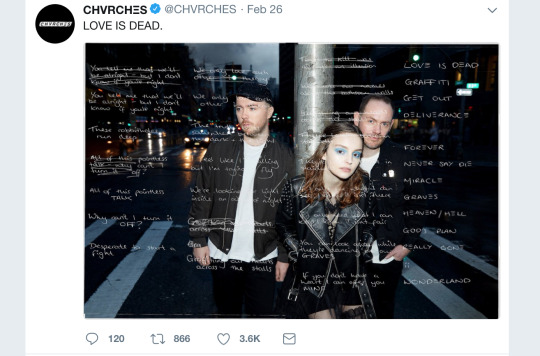
27th February - The band release the second single off the album, “My enemy”, again premiered on BBC’s Radio 1.
28th February - On all social media the name of the album, hinted at in previous posts, is released - “Love is Dead”, and the date of release May 25. A link is left to pre-order the album.
29th February to 27th March - Chvrches continue to promote their album through advertising album presages and merchandise. The band also begin performing live on radio stations (BBC Radio 1, i-heart Radio etc), performing new songs and covers. The band also share behind the scenes footage of recordings, and advertise upcoming festivals they will be attending.
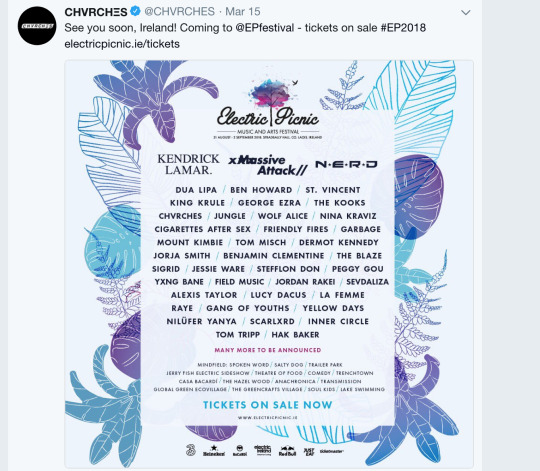
28th March - Chvrches release “Never Say Die”, the third single off their album, on all streaming platforms. The band do not advertise a certain radio station at which it will be premiered.
29th March to 9th April - The band continue to advertise their album, show they will be playing at and give behind the scenes look into photoshoots, performances etc. They also promote several charities the band is involved with, and give interviews in which Mayberry discusses sexism in the music industry.
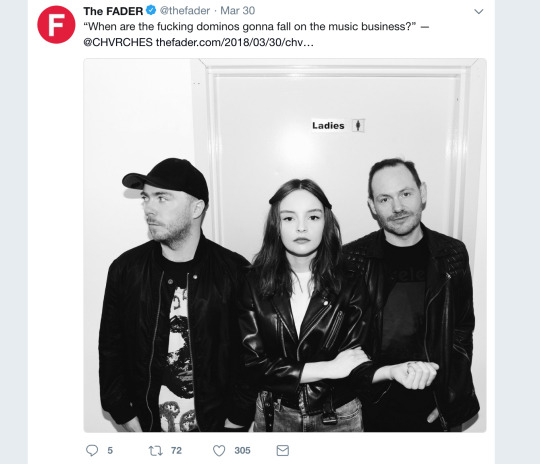
10th April - Chvrches release “Miracle”, their fourth single, on all streaming platforms.
12th April - The band promote new merchandise, including jewellery, on Facebook and Twitter, along with limited addition cassette tapes available for pre order.
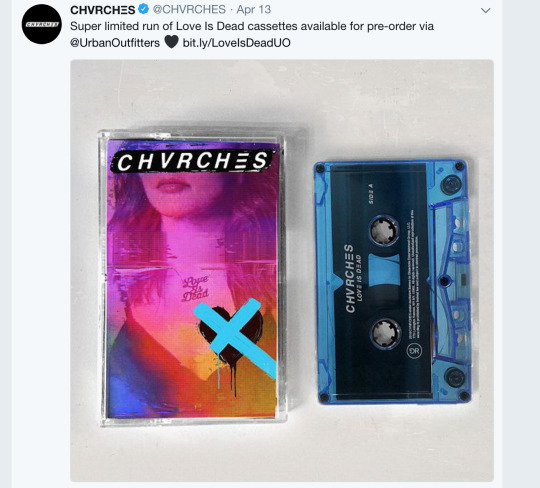
Assessment
Strengths
The very beginning of Chvrches promotion campaign, deleting all past presence on social media, is wholly original and clever. The connotations of this move are innumerable; it could signify the band going in a completely new direction (which has turned out not to be the case). It could signify that the band is starting fresh, that the past doesn't matter. The confusion and intrigue the decision createe in the bands fanbase makes up for any negative side affects, at least in the short term and as pertains to “Love is Dead”.
The massive variety of merchandise, and the content in general, that Churches advertise is a selling point. Clothes, jewellery, records, cassettes and more are available through their online store. Live performances, online articles, interviews and behind the scenes footage all feature prominently in their feeds, ensuring there is something for everyone of their fans.
Weaknesses
While the starting point of the campaign was excellent, the first three posts on the bands social media set a tone that is completely lost 2 weeks later. Intrigue and mystery surrounded the initial video of Mayberry drawing a heart, followed by a static low quality video vaguely showing another heart, and then the symbol itself with a link to the lead signal. There were no explicit quotes or pictures from the band. Had this tone continued throughout the months, it is possible that even more intrigue and mystery could have been created surrounding the album, increasing the fans desire for it to be released. However the 4th post shows the band smiling goofily underneath a billboard advertising their new single.
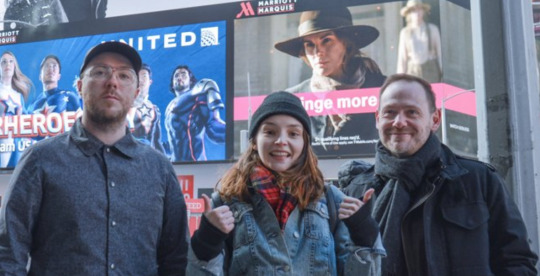
The mystery disappears. There are singular posts on Instagram that allude to the tone initially established, but they made redundant (and even off putting) by the now standard promotional campaign they belong to.
Churches also do not separate their campaign posts (merch, gigs, behind the scenes etc) between social media platforms. Their twitter and Facebook feeds are nearly identical, and everything that is on Instagram can be found on Facebook. The is a monotony to their posts on each platform, especially Twitter and Facebook.
Opportunities
Separating posts (photos, behind the scenes on Instagram, prompting gigs, articles, dates on Facebook etc) is a good way to provide fans with a unique experience on each platform.
Apart from one AMA on Reddit, there is little evidence of fan interaction on their social media. This is a massive opportunity to improve for the band. Through twitter and Facebook especially, it is especially easy to talk and discuss topics with fans (even lowly QUT Students). Even small interaction can inspire massive loyalty and love within fans.
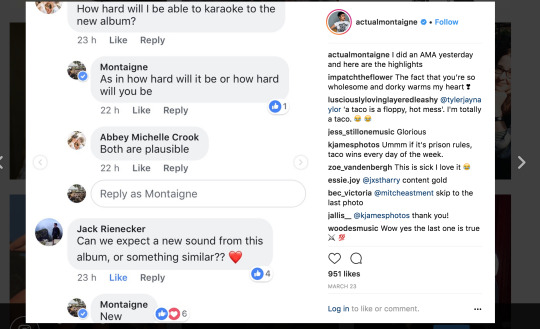
Threats
Due to their massive popularity, which has occurred over a very short space of time, the band will have several employees operating their social media. There is a possibility that, if Mayberry and co are not proactive, their presence online will lose any sense of personabillity, and connections with fans will be that much harder to make. Audiences and music fans, while understanding the stresses of being in a popular band, value authenticity above most other things.
There is also a possibility that the amount of politically themed content posted during the campaign could have a negative impact on how the band is viewed. In a society that is increasingly resistant to celebrities having an opinion on politics, however valid, care must be taken by the band to not become overbearing.
0 notes
Text
Assessment 2 Annotated Bibliography
Topic - There are documented health risks to frequent and extended exposure to music higher than 105 decibels. Why is this not a major issue in the music industry, and how can we change the communities attitude for the better?
Bogoch, I. (2005). Perceptions About Hearing Protection and Noise-Induced Hearing Loss of Attendees of Rock Concerts. Canadian Journal of Public Health, 34(1), 68-72.
A 2005 survey of 204 rock concert goers. 70% of the audience believed it to be likely or severely likely that the noise levels of the concert could damage their hearing, but 80% said they had never worn hearing protection. Tinnitus had been experienced by 84 percent of the crowd. If free earplugs were offered at entry for free, a majority of those surveyed said they would use them. The study was conducted for the highly reputable Canadian Journal of Public Health, and peer reviewed. It is not specified what kind of concert it was where the survey was taken, other than “rock”, but we can presume from the data that the people who participated are regular concert attendees. The results of Bogoch’s survey contains data that is contrary to the narrative pushed by Cohen in his article. Bogoch’s survey shows that an overwhelming majority of concert goers were aware that their hearing was at risk of being damaged, yet over 80% say that they'd never used earplugs. This is an important finding, and Cohen’s study doesn’t attempt to explain the result.
Cohen, J. (2015). Could one concert do a lifetime of damage to your ears? Retrieved from
http://www.dailyherald.com/article/20150803/entlife/150809940/
Cohen details the multiple hearing disabilities that can occur in later life to regular concert goers and industry professionals.Cohen interviews several industry professionals, who were either unaware or unconcerned of the detrimental side effects. The article uses multiple outside sources including studies by the American National Institute of Health and the University of Iowa. Joyce Cohen, the articles author, is the special correspondent for Health and Science for The Washington Post (a reputable newspaper). The personal testimonies that Cohen has collected are useful in two ways. They show that many industry professionals are unaware of the dangerous side effects, and they show how debilitating the side effects are. Interviews with scientific researchers also highlight how imperative it is to make people aware of the effects. My argument, that the general concert going public are ill-informed on the subject, is well backed up by Cohens interviews.
Chung, J.H. (2005). Evaluation of Noise-Induced Hearing Loss in Young People Using a Web-Based Survey Technique. Offical Journal of the American Academy of Paediatrics, 115(4), 861-867.
An online 28 question web survey conducted on 9693 people, targeted on adolescents and young adults. The survey asked the participants to rate various health concerns on how large a problem they perceived them to be. Though the journal the study was conducted for is reputable, there is no way to ensure the online survey results are not skewed in some way, however unlikely. Only 8% of participants rated hearing loss as “a very big problem”, compared to 47% for drug and alcohol abuse, but this is hardly surprising, as symptoms only show later in life. In this way, the study is in part useless.
Sadra, S. (2002). Noise Exposure and Hearing Loss among Student Employees Working in University Entertainment Venues. The Annals of Occupational Hygiene, 46(5), 55-463.
A 2002 study that surveyed students working at a university music venue, testing temporary threshold shifts and the maximum sound levels experienced by the workers. Only 14 students were convinced to undertake the test, a very small sample size. Only one venue was tested, and it may not be representative of the majority. The source is useful in one way; a reading of 124 db was taken in a spot where security staff often work 5 shifts. This is illegal, and points to more occurrences of a similar nature in other venues.
Safe Work Australia. (2017). Noise. Retrieved from https://www.safeworkaustralia.gov.au/noise
The webpage details the laws that currently apply to the amount of noise workplaces can legally create. It also explains the science behind why the limits are set where they are. The webpage contains only facts, on Australian laws and the proven science behind the safety limits the government has implemented. The webpage offers insight into the Australian Government’s view on noise regulations in the workplace. The Government believe that the main industry that it’s laws applies to is that of construction/industrial work. The live music industry is not mentioned once, despite there being numerous evidence of breaches in Health and Safety laws. The ignorance of the Australian public is paralleled by the government.
Sanford, J. (2008). Rock Concerts Are Destroying Your Hearing! Retrieved from https://www.sandiegoreader.com/weblogs/bands/2008/jan/06/rock-concerts-are-destroying-your-hearing/
Sanford gives a more thorough breakdown of the science behind the side effects of loud music, and details the physical process that occurs in the ear to cause the deterioration. He interviews several experts on the subject (audiologists) and summarises American government policies that attempt to combat the problem in the workplace. The article is also throughly researched, with numerous outside sources cited and interviews with audiologists who present the facts straightforwardly . Sanford cites two studies that suggest there is a strong correlation between an inability to hear high frequencies and regular concert attendance. These will be invaluable. Sanford’s investigation into legal cases involving patrons who allege a venues loud music has caused them damage will also be useful. He finds that there is very little legal precedent for charging the venue, as the specific cause hearing damage, theoretically, could be anything.
Yassi, A. (1993). Risks to Hearing from a Rock Concert. Canadian Family Physician, 39(1), 1045-1049.
The 1995 study tested the temporary threshold shift participants experienced after a rock concert. 81% displayed a shift of 10 decibels or more. The study only used 28 people; a larger sample size would have given the study more scientific clout. Otherwise the results are reliable. The main piece of data to take away from this study is that the subject of hearing damage caused by loud music has been studied for over 20 years. What steps have been taken in that time to counteract the problem? Almost none.
0 notes
Text
“How to Socialise & Make Friends” Review - Camp Cope
After a meteoric rise to national fame in 2016 and an american support tour, Melbourne indie rockers Camp Cope (Georgia McDonald, Kelly-Dawn Hellmrich and Sarah Thompson) have returned with their second LP “How to Socialise & Make Friends”. With an “if it ain’t broke” attitude, the band have created an album that could be an identical twin to their debut. McDonald’s ferociously emotional lyrics and vocals dominate the LP, with no perceivable change to the bands sound. For pre-existing fans of Camp Cope this will be welcome news, but does it translate into an interesting album?
Track one, “The Opener”, is a song that perfectly encapsulates “How to Socialise & Make Friends”. The bass, drums and electric guitar are limited to one rhythm and chord progression throughout the entire 3:40 minute runtime, with very little variation to distinguish one section from another. The mix is extremely dry (the album was recorded in just two days), with very little dynamic range or expression audible. Producer Sam Johnson deliberately kept the sessions as “bare bones" as possible, to reflect the bands live sound. Unfortunately the effect this has is to detract from the emotion we hear in McDonalds vocals. On “The Opener” when she furiously screams “…now tell me again how there’s just not that many girls in the music scene!” there is no change in the music at all; the guitars continue strumming and the drums keep plodding monotonously. The justified outrage and sadness that McDonald expresses throughout the album isn’t mirrored or supported by the music.
There are exceptions to this pattern: “Omen” employs two guitars, one of which plays delicate arpeggios. The song is a feature, only because it is the only song on the album that features anything other than guitar strumming, and provides a respite from the monotony. “The Face of God” is as close as the album comes to a song with atmosphere and character; McDonald’s melody line is complimented nicely by the drummers use of cymbals. The closer, “I’ve Got You”, stands out only for its change in instrumentation, McDonald using an acoustic guitar to pay tribute to her fathers battle with illness: “You said there’s broken links in your brain, I said it’s okay mine’s exactly the same”. The acoustic guitar compliments her lyrics and use of rhythm nicely, and is a suitably sentimental end.
However it is not enough to save the rest of the album. The tracks “Anna” and “Sagan Indiana” are practically interchangeable; both sound extremely similar to “The Opener”, as does the title track. The multiple crescendos on “Animal and Real” lack any real punch due to the blandness of Johnson's production, as does the driving drum beat on “UFO Lighters”. There is never a moment when the guitar rock has any power, emotionally or otherwise.
For some listeners these shortcomings won’t matter; McDonald’s personable lyrics are the hi-light of the album, and the instrumentals are just a backdrop. But is that really a good enough excuse for characterless, monotonous music? Plenty of bands incorporate both deeply emotional lyrics and exciting instrumentals to stunning effect. Big Thief’s “Paul”, Mitski’s “American Girl” and Stella Donnelly’s “Boys Will be Boys” to name a few. For now, Camp Cope are several cuts below that standard. When McDonald complains “It’s another man telling us we’re missing a frequency”, its hard not to see where he’s coming from. 3/10
0 notes
Photo

At the end of the day, all that matters is that your music is good.
0 notes